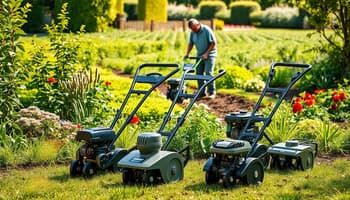Do You Need a Garden Tiller? Pros, Cons
As a homeowner, I’ve often wondered if a tiller is worth the cost. With many options, deciding to buy or rent can be tough. Garden tillers make preparing soil easier. They save time and effort. But, it’s key to consider the pros and cons before deciding. In this article, I’ll look at the good and bad sides of using a tiller. Plus, I’ll share top picks for the best models out there. Key Takeaways Understanding Garden Tillers and Their Purpose A garden tiller is a strong tool for gardening. It breaks up and aerates the soil, making it ready for planting. Knowing how a garden tiller works can really help with preparing your soil. What Is a Garden Tiller? An electric tiller uses electricity to power its work. It has metal blades called tines that spin and mix the soil. This action loosens the soil and adds organic matter, making it better for plants. How Garden Tillers Transform Your Soil Garden tillers make your soil better by loosening and aerating it. This helps plants grow stronger roots and absorb water better. They also remove weeds and debris, making the soil ready for new plants. These tools are especially good for gardens with heavy clay or sandy soils. They improve the soil’s texture and structure. Regular use of tillers can also prevent soil compaction, helping roots grow and improving drainage. When You Need a Garden Tiller Before you start tilling your garden, it’s key to know when it’s needed. A garden tiller is useful but should be used wisely to protect your soil. Signs Your Garden Could Benefit from Tilling If your garden has compacted soil, weeds, or debris, a tiller can help. It loosens the soil, improves drainage, and removes unwanted growth. It’s also useful for starting new garden beds or adding organic matter to your soil. When to Avoid Using a Tiller While a garden tiller is helpful, it’s not always the best choice. Landscape designer Ward Dilmore warns against over-tilling, as it harms soil organisms. If your soil is already loose and well-structured, tilling can harm it. Also, tilling can worsen erosion in gardens prone to it. Choosing to use a garden tiller depends on your gardening needs. Knowing when to till and when to avoid it helps you use this tool effectively. This way, you can have a healthier, more productive garden. Types of Garden Tillers Explained Garden tillers come in different types, like front-tine, rear-tine, and mini-tillers. Knowing these differences helps you pick the best soil preparation tool for your garden. Front-Tine Tillers Front-tine tillers are light and easy to move around. They’re great for small gardens or tight spaces. They’re also cheaper and easy to store. But, they might not work well with hard soil or big areas. Rear-Tine Tillers Rear-tine tillers are stronger and better for big gardens or hard soil. They can dig deeper and handle different soils, like clay and rocky ones. They’re sturdy but can be heavy and hard to handle. Cultivators and Mini-Tillers Cultivators and mini-tillers are for smaller gardening jobs. They’re perfect for keeping garden beds in shape, mixing in fertilizers, or loosening soil. These small tools are light and simple to use, great for small gardens. For more info on picking the right garden tiller, check out https://learn.compactappliance.com/tillers/. It has detailed guides and reviews. Tiller Type Ideal Use Key Features Front-Tine Smaller gardens, tight spaces Lighter, easier to maneuver Rear-Tine Larger gardens, tough soil More powerful, deeper tilling Cultivators/Mini-Tillers Small-scale gardening, maintenance … Read more

